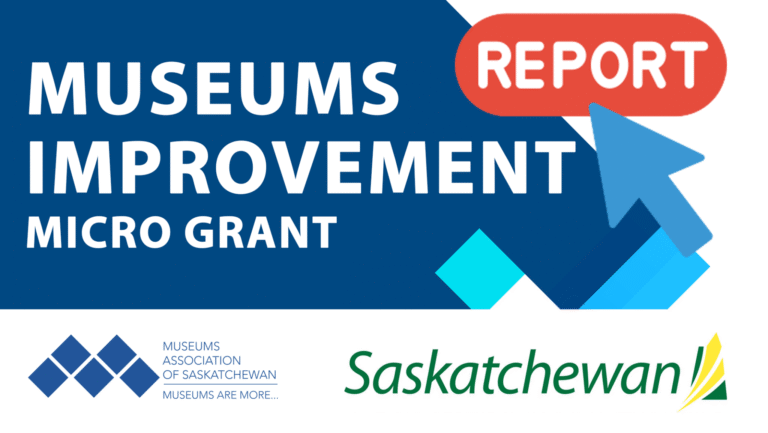Assistant Curator – Wanuskewin Heritage Park
Are you an emerging Indigenous museum professional ready to help share stories that have lived on this land since time immemorial? Wanuskewin Heritage Park invites you to step into a
A Museum’s Rights and Deaccessioning the Collection
By Chris Selman and Kathleen Watkin
As museums grow and evolve to meet the needs of their communities, they often find themselves with artifacts which need be deaccessioned (removed) from their collection for a variety of reasons. The most commons reasons for deaccessioning include:
When Can Deaccessioning Occur?
A museum can only deaccession an artifact when it holds legal title, with proper supporting documentation regarding its ownership. This means that a gift agreement or transfer of ownership form has been signed. The Museum Association of Saskatchewan advices that you include the following clause, or one similar, in your gift agreements or transfer of ownership forms.
I (we) unconditionally give to the museum the property described above which I (we) own, and transfer full title and all privileges of ownership.
The Museum reserves the right to display, loan, use or dispose of (deaccession) the property at its own discretion.
The Museum acknowledges receipt of the property and accepts unconditional ownership of the property described herein.
If there is any question regarding ownership, the museum cannot deaccession the artifact. This also applies to artifacts that have been loaned to the museum – including those on “permanent” or “indefinite” loan. If a museum is in this position, they must attempt to return the unwanted object to its owner or their heirs.
Once the museum’s legal title has been established, the museum’s Board of Trustees and/or Collections Committee must agree that the item can be deaccessioned. Once permission is received, the artifact can be deaccessioned and disposed of.
Deaccessioned Artifacts: now what?
If an artifact meets the museum’s deaccessioning criteria and formal approval has been received, the artifact can be deaccessioned from the collection. Always keep in mind that museum collections are held in trust on behalf of the public, and keeping deaccessioned artifacts in the public domain (i.e. within other museum collections) should be the priority.
Criteria for disposal will be described in the museums deaccession policy, but the following pattern provides a template:
First Priority: Reach out to other museums and see if they would like the artifact for their collection as either a gift or a trade. If another museum wants the artifact, be sure to transfer the title of the artifact to them.
Note: If the deaccessioned artifact is a sacred or sensitive artifact, contact the First Nations community and ask them to advise you on how to repatriate the artifact to them.
Second Priority: Sell the artifact to another public institution or to the public. The sale should be conducted through an unbiased third-party. This will prevent conflicts of interest and ensure openness in the eyes of the public. Any profit made through the sale of the artifact should be put towards projects that directly support the museum’s collection (i.e. new storage, new acquisitions) and not for capital projects.
Final Priority: Have the artifact safely destroyed. A museum should only consider this option if the artifact poses a health and safety risk, and/or is severely deteriorated. Destruction of other deaccessioned artifacts should be considered only when all other avenues have failed.
Deaccessioned artifacts should not be returned to their original donors (even if no tax receipt was originally issued) for risk of losing charitable status. However, museums may choose to alert the public, and donors, regarding decisions to deaccession artifacts (including rationale, method etc.) to maintain openness.
Records Management
Throughout the deaccessioning process, it is very important that museums update their documentation. This includes but is not limited to meeting minutes, notes, and correspondence regarding the rationale and decisions resulting from the deaccession. All records associated with the artifacts chosen for deaccessioning should be flagged and dated. Before disposal all deaccession numbers should be removed from the objects.
Once disposal has occurred, all files should once again be updated accordingly. This includes listing the method of disposal, any associated individuals or organizations, and updating the artifact’s location.
A thorough record of all funds acquired through disposal should also be maintained, along with details any projects or purchases completed with this money.
For More Information, See:
“Collections Documentation Manual for Saskatchewan Museums.” Museum Association of Saskatchewan. Regina, Saskatchewan. 2014
Gerrard, Richard. “An Introduction to the Deaccession and Disposal of Collections.” Ontario Museum Association Learning Lab Summer Series. 2013
National Park Service, “NPS Museum Handbook, Part II: Museum Records, Chapter 6 “Deaccessioning.” 2016. Website: http://www.nps.gov/museum/publications/MHII/mh2ch6.pdf
Simmonds, John E. “Things Great and Small: Collections Management Policies.” American Associations of Museums. 2006
“Standards for Saskatchewan Museums.” Museum Association of Saskatchewan. Regina, Saskatchewan. 2016
Are you an emerging Indigenous museum professional ready to help share stories that have lived on this land since time immemorial? Wanuskewin Heritage Park invites you to step into a

Usual office hours will resume on January 5th, 2026

Just a reminder that the Final Report for the Museum Improvement Micro Grant for Community Museums is due December 5th! Your final report will require you to provide a brief